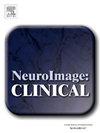Multivariate neural markers of individual differences in thought control difficulties
IF 3.4
2区 医学
Q2 NEUROIMAGING
引用次数: 0
Abstract
This study identified specific patterns of brain activity distributed within and across four different brain networks associated with an individual’s difficulties in controlling thoughts, a transdiagnostic feature of mental health disorders. Previously, we demonstrated that four working memory control operations—maintaining, replacing, suppressing, and clearing thoughts—are represented by distinct multi-voxel patterns of brain activation. Moreover, the exact pattern that characterizes these operations is distinct across four sets of brain regions, referred to as working memory operation networks, that include a Visual Network (VN), Somatomotor Network (SMN), Default Mode Network (DMN), and Frontoparietal Control Network (FPCN). The current study examined the hypothesis that aspects of these multi-voxel patterns are associated with an individual’s difficulty in controlling thoughts, as derived from a composite of three self-report questionnaires, in a non-clinical (N = 48) sample. Consistent with our hypothesis, three effects were observed. Individuals with higher levels of thought-control difficulty have less distinct multi-voxel patterns for each of the four operations, have a less distinct representation of the suppression and clear operations in the DMN network from its representations in other networks, and have a more variable representation of multiple operations within each of the FPCN, VN and SMN networks. These neural patterns accounted for over 30 % of the variance in self-reported thought difficulties. Moreover, these associations were specific to working memory operations as they were not observed at rest, highlighting their relevance for understanding the neural mechanisms of repetitive negative thinking and their potential as biomarkers for interventions targeting impaired thought control.
思想控制困难个体差异的多元神经标记
这项研究确定了分布在四个不同的大脑网络内部和之间的特定大脑活动模式,这些网络与个体控制思想的困难有关,这是精神健康障碍的一种跨诊断特征。先前,我们证明了四种工作记忆控制操作——维持、替换、抑制和清除思想——是由不同的大脑激活的多体素模式代表的。此外,表征这些操作的确切模式在四组大脑区域之间是不同的,这些区域被称为工作记忆操作网络,包括视觉网络(VN)、躯体运动网络(SMN)、默认模式网络(DMN)和额顶叶控制网络(FPCN)。目前的研究检验了一个假设,即这些多体素模式的各个方面与个人控制思想的困难有关,该假设来自于一个非临床样本(N = 48)的三份自我报告问卷的合成。与我们的假设一致,观察到三种效应。思维控制难度较高的个体在四种操作中的多体素模式差异较小,在DMN网络中的抑制和清晰操作的表征与在其他网络中的表征差异较小,并且在FPCN、VN和SMN网络中的多个操作的表征更可变。这些神经模式占自我报告思维困难差异的30%以上。此外,这些关联是特定于工作记忆操作的,因为它们在休息时没有被观察到,这突出了它们与理解重复性消极思维的神经机制的相关性,以及它们作为针对思维控制受损干预措施的生物标志物的潜力。
本文章由计算机程序翻译,如有差异,请以英文原文为准。
求助全文
约1分钟内获得全文
求助全文
来源期刊

Neuroimage-Clinical
NEUROIMAGING-
CiteScore
7.50
自引率
4.80%
发文量
368
审稿时长
52 days
期刊介绍:
NeuroImage: Clinical, a journal of diseases, disorders and syndromes involving the Nervous System, provides a vehicle for communicating important advances in the study of abnormal structure-function relationships of the human nervous system based on imaging.
The focus of NeuroImage: Clinical is on defining changes to the brain associated with primary neurologic and psychiatric diseases and disorders of the nervous system as well as behavioral syndromes and developmental conditions. The main criterion for judging papers is the extent of scientific advancement in the understanding of the pathophysiologic mechanisms of diseases and disorders, in identification of functional models that link clinical signs and symptoms with brain function and in the creation of image based tools applicable to a broad range of clinical needs including diagnosis, monitoring and tracking of illness, predicting therapeutic response and development of new treatments. Papers dealing with structure and function in animal models will also be considered if they reveal mechanisms that can be readily translated to human conditions.
 求助内容:
求助内容: 应助结果提醒方式:
应助结果提醒方式:


